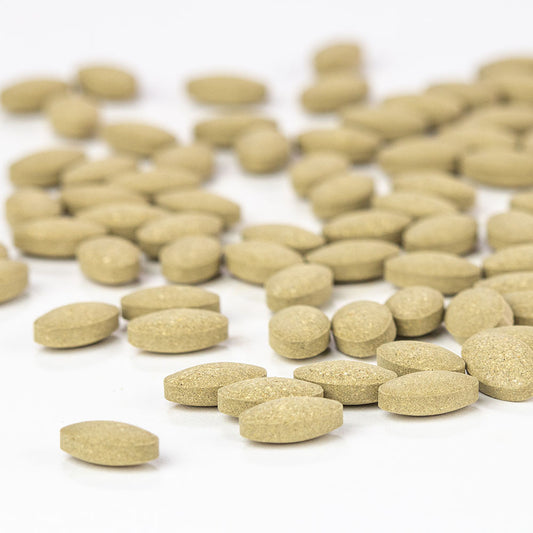Clinical Trial on Tranquil Mind™ Tablets White Paper
A Placebo-Controlled Clinical Study
In today's world, we lead active lives that are packed with busy schedules and long lists of things we want to accomplish. This busy pace can often be accompanied by feelings of too much to do, which can naturally lead to feelings of overwhelm, stress, mental agitation, nervousness, and anxiousness.
Banyan Botanicals designed Tranquil Mind tablets with herbs renowned in Ayurveda for their work in the nervous system and mind to promote mental calmness and enhance a sense of peace and well-being without causing dullness or lethargy.
To test the efficacy of this formula, Banyan Botanicals launched and executed a pilot study. This was a randomized, double-blind, placebo-controlled clinical trial that compared the herbal formula Tranquil Mind to a placebo in its effectiveness to decrease signs of anxiousness, fear, and worry as measured by a validated questionnaire.
In addition, the study was also designed to understand feasibility for a larger placebo-controlled study in the future.
Ayurveda's Approach to Anxiousness
Feeling anxious is an emotion characterized by feeling tense and having worried thoughts that just about everyone experiences time to time in life. It is the occasional worry about circumstantial events that may lead to fear and distress.
Ayurveda has a unique approach to understanding anxiousness. In Ayurveda, anxiousness is especially related to an imbalance in vata dosha, which governs movement and communication in the body and plays a key role in the nervous system and mind. In fact, anxiousness is a quintessential vata emotion when vata is out of balance. Hectic lifestyles can provoke vata, leading to mental agitation, nervousness, and anxiousness.
Ayurveda recognizes that removing all stressors is not necessarily the solution, as not all of them are avoidable. Instead, our response to the stressors is key. Balancing vata through a supportive lifestyle, diet, and herbs is one of the most effective ways we can regain our equilibrium.

The Formula
The Tranquil Mind herbal formulation consists of the following powdered herbs:
- Eclipta alba (bhringaraj leaf)
- Scutellaria lateriflora (skullcap herb)
- Passiflora incarnate (passion flower)
- Tinospora cordifolia (guduchi stem)
- Matricharia chamomilla (chamomile flower)
- Centella asiatica (gotu kola leaf)
- Withania somnifera (ashwagandha root)
- Ipomea digitata (finger-leaf morning glory/vidari kanda root)
- Foeniculum vulgare (fennel seed)
- Piper longum (pippali fruit)
Total herb weight per tablet is 500 milligrams.
According to Ayurveda, herbs work synergistically together. The herbs in this formula were chosen because of their known work in the mind and nervous system, as well as their ability to help the body cope with and maintain equilibrium when faced with stress.
Bhringaraj, for example, is excellent for soothing the mind, while skullcap and chamomile work together to calm the nervous system. Gotu kola is sattvic (pure, harmonious, and brings clarity) and supports the proper function of the nervous system. Ashwagandha is a famous adaptogen, helping the body adapt to stress.

The Clinical Study
31 healthy participants completed the trial. At the beginning of the trial, each person was randomly assigned to one of the two groups, Tranquil Mind or placebo. Participants took three tablets twice daily for a period of two weeks.

On the first day of the trial, participants completed a validated questionnaire to assess their level of anxiousness. The same questionnaire was completed on day 14, the last day of the trial period. The questionnaire contained 29 questions, which targeted mental, emotional, and physical states when participants experience anxiousness.
For each question, they ranked on a scale of one to five on how often they experience certain signs of anxiousness, with a higher score (five) representing a higher level of anxiousness. The total score of all 29 questions can be between 29–145.
At the end of the study, the difference in scores from the pre- and post-trial questionnaire were compared. Once the data from the questionnaire were organized for the Tranquil Mind and placebo groups, descriptive and inferential statistics were computed. 1

The Results
We discovered a significant decrease in score in the level of anxiousness, indicating the effectiveness of the treatment administered of Tranquil Mind tablets versus placebo.
In other words, those who took Tranquil Mind had statistically significant results, with a 25–50% decrease in signs of anxiousness by the end of the 2-week study period.
At first glance, it also appears that the placebo group had noteworthy results. However, it's important to note that, when the results are broken down by question, well over half of the results for the placebo group are not statistically significant and are not caused by the placebo itself.

How We Analyzed the Results
To evaluate the significant difference between the two groups, we performed an unpaired t-test with Welch's correction,2 and we used a p-value of 0.05 to understand if the results observed were statistically significant. 3 If the p-value is less than 0.05, we can conclude that the effect of Tranquil Mind tablets on anxiousness was truly significant.
The analysis revealed that there was a significant difference (p-value less than 0.05) between Tranquil Mind and Placebo groups, with a p-value of 0.0194. We can confidently conclude that the results of the Tranquil Mind group were statistically significant, and as such, the tablets are effective in alleviating anxiousness.
Taking a Closer Look at the Results
Average Percent Decrease

Figure 1: Average percent decrease in Tranquil Mind vs Placebo groups.
* Significant with a p-value of <0.05
**** Extremely significant with a p-value of <0.0001
Figure 1 gives a visual representation on the average difference of pre-trial and post-trial for Tranquil Mind and placebo groups. The Tranquil Mind group showed an overall extremely significant results of 37.8% decrease in anxiousness with a p-value of less than 0.0001%, compared to the placebo group at 20% decrease with a significant p-value of less than 0.05%.
Note: Smaller p-value indicates greater effect of the product in decreasing level of anxiousness.
We also computed if there were any significant differences in each question on the questionnaire. 4
The results were fascinating: the Tranquil Mind group showed more significant difference in each question than the placebo group.
In other words, in the Tranquil Mind group, there was an overall significant decrease in anxiousness, along with a significant decrease for each question that measured signs of anxiousness. There were only 11 questions out of 29 that showed significant difference in placebo group as compared to Tranquil Mind, which had 27 questions with significant difference.
This is one of the factors that contributed to the smaller p-value (less than 0.0001, or 0.01%) in the Tranquil Mind group to the larger but still significant p-value (0.0198, or 1.98%) in the placebo group as depicted in figure 1.
“I Felt Fearful”

Figure 2: Participants who took Tranquil Mind were 25% less fearful than before.
** Very significant with a p-value of <0.005
Participants who took Tranquil Mind were 25% less fearful than before, depicting the percent decrease in score from before and after taking Tranquil Mind or placebo tablets. This was also a significant decrease with a p-value of less than 0.05.
“It Scared Me When I Felt Nervous”

Figure 3: Participants who took Tranquil Mind said that they were 35% less scared when they felt nervous.
*** Highly significant with a p-value of <0.0005
Participants who took Tranquil Mind said that they were 35% less scared when they felt nervous. On the contrary, those who took placebo also mentioned they felt 27% less scared when nervous but this change wasn't statistically significant. This can mean that those using the placebo felt a decrease in fear because of other factors in their lives, not because of the placebo.
“I Felt Upset”

Figure 4: Participants who took Tranquil Mind felt 30% less upset than before.
*** Highly significant with a p-value of <0.0005
Participants who took Tranquil Mind felt 30% less upset than before, showing the percent decrease in score from before and after taking Tranquil Mind and placebo tablets. The placebo group's results were not statistically significant (p-value greater than 0.05) and were likely caused by other factors, not the placebo.
“I Was Anxious If My Normal Routine Was Disturbed”

Figure 5: Participants who took Tranquil Mind said that they were 39% less anxious when their daily routine was disturbed.
*** Highly significant with a p-value of <0.0005
The placebo group's results were not statistically significant and were likely due to other factors, not the placebo.
“I Was Easily Startled”

Figure 6: Participants who took Tranquil Mind experienced a 37% reduction in feeling easily startled.
*** Highly significant with a p-value of <0.0005
The placebo group's results were not statistically significant and were likely due to other factors, not the placebo.
“I Avoided Public Places or Activities”

Figure 7: Participants who took Tranquil Mind were 36% less likely to avoid public places or activities.
*** Highly significant with a p-value of <0.0005
Participants who took Tranquil Mind were 36% less likely to avoid public places or activities. This was a very significant decrease with a p-value of less than 0.005. The placebo's results were not statistically significant.
“I Felt Something Awful Would Happen”

Figure 8: Participants who took Tranquil Mind were 45% less likely to feel something awful would happen.
**** Extremely significant with a p-value of <0.0001
Participants who took Tranquil Mind were 45% less likely to feel something awful would happen. This was extremely statistically significant with a very low p-value. While participants who took placebo also mentioned a decrease in this feeling, the change is not validated and is not statistically significant.
“I Found It Hard to Focus On Anything Other Than My Anxiousness”

Figure 9: Participants who took Tranquil Mind felt 49% less hard to focus on anything other than their anxiousness.
**** Extremely significant with a p-value of <0.0001
Participants who took Tranquil Mind felt a 49% reduction in difficulty focusing on anything other than their anxiousness, which were extremely statistically significant. Participants who took the placebo did not have statistically significant results.
“My Worries Overwhelmed Me”

Figure 10: Participants who took Tranquil Mind reported a whopping 50% decrease in feeling like their worries overwhelmed them.
**** Extremely significant with a p-value of <0.0001
Participants who took Tranquil Mind reported a whopping 50% decrease in feeling like their worries overwhelmed them, and by the end of the trial, they said that they rarely felt overwhelmed by their worries. The results were extremely statistically significant. The results from the placebo group were not statistically significant and were likely caused by other factors.
“I Had Twitching or Trembling Muscles”

Figure 11: The Tranquil Mind group showed an average of 42% decrease in physical signs of anxiousness.
** Very significant with a p-value of <0.005
The Tranquil Mind group showed an average of 42% decrease in physical signs of anxiousness, such as twitching or trembling muscles. These results are statistically significant. The results of the placebo group were not statistically significant and were likely due to other factors.
“I Had Trouble Relaxing”

Figure 12: Participants who took Tranquil Mind reported an average of 45% decrease in trouble relaxing.
**** Extremely significant with a p-value of <0.0001
Participants who took Tranquil Mind reported an average of 45% decrease in trouble relaxing, meaning that Tranquil Mind tablets helped them feel relaxed with less trouble. The results were extremely statistically significant. The placebo group did not have statistically significant results and were likely caused by other factors.
“I Felt Uneasy”

Figure 13: The Tranquil Mind group expressed an average of 45% decrease in uneasiness.
**** Extremely significant with a p-value of <0.0001
The Tranquil Mind group expressed an average of 45% decrease in uneasiness. The results were extremely statistically significant. Placebo group showed no statistically significant difference and the results are invalidated.

Final Thoughts
The results are very encouraging! This pilot clinical study shows that Tranquil Mind tablets are clearly effective in significantly decreasing signs of anxiousness in participants, as evaluated by the validated questionnaire.
This is a promising step in better understanding how Tranquil Mind can effectively alleviate anxiousness and correlated signs. We can conclude that Tranquil Mind tablets are safe and effective and can be used as a key product in maintaining mental and emotional equanimity as well as supporting the experience of occasional anxiousness.
A larger, randomized, controlled study, with at least 100 participants, would be the next step in helping us better evaluate the efficacy of Tranquil Mind on anxiousness.
More for You
Cultivating Calm
Do you struggle with feeling anxious or fearful? Read this guide on finding balance throughout the mental and emotional spheres with the help of Ayurveda.
10 Yoga Poses for Relaxation & Calm
These ten simple postures can support the parasympathetic nervous system and create a sense of calm. Give them a try the next time you’re feeling out-of-sorts.
References
1 This means that we performed a normality test to further establish the type of statistical analysis that needed to be performed. Tranquil Mind and placebo groups passed for normality test (alpha at 0.05) and the groups were further analyzed using parametric tests, which includes paired and unpaired Student's t-tests. We used the Graphpad software to compute the descriptive and inferential statistics.
2 The unpaired t-test is a form of hypothesis testing that examines whether the difference between scores for anxiousness are statistically different between the Tranquil Mind and placebo groups.
3 A p-value determines how likely results are due to chance. The p-value for this trial was set at 0.05, or 5%. If less than 0.05, meaning that the results showed over 95% likelihood that the results are due to the hypothesis, it is statistically significant. The lower the p-value, the higher the statistical significance of the results.
4 We used a paired t-test.








